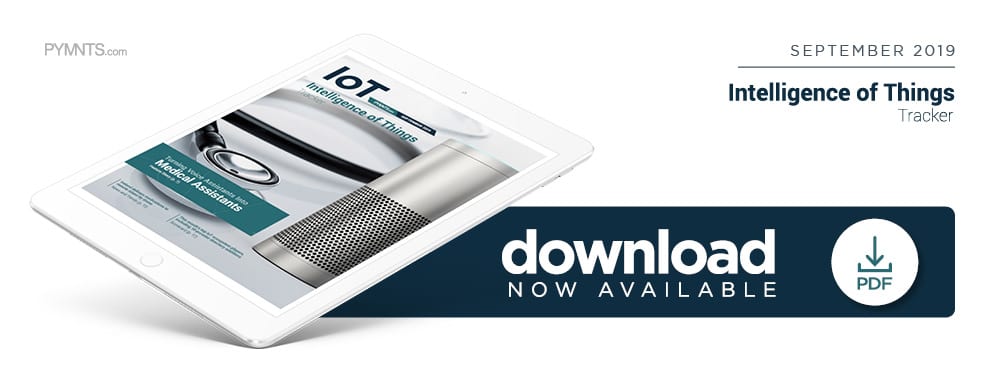Turning Voice Assistants Into Medical Assistants

Handling patient billing and other paperwork can keep doctors from focusing on patients and drag down optimal care. But, using smart voice assistants in exam rooms to take over bill-related record keeping can allow doctors to focus more on patient care, says Robin Healthcare Co-Founder and CEO Noah Auerhahn. In the latest IoT Tracker, he explains how IoT-enabled video- and audio-recording devices can cure billing woes, while ensuring patient privacy and safe handling of sensitive medical data.
The complex healthcare billing and administrative requirements of the U.S. mean that doctors looking to be paid for their work and protected from lawsuits must spend a portion of their face time with patients scribbling notes for record-keeping. That time and expense can be a major pain point for patients, physicians and clinics alike. A 2018 study found the U.S. healthcare system spends at least twice as much as its Canadian counterpart on administrative costs, for example.
Even practices that use electronic health records (EHRs) for automatic bill generating still dedicate significant amounts of time and money to handling billing and insurance-related activities. Billing and insurance claims processing requires anywhere from an average of 13 minutes and $20.49 for a primary care visit up to 100 minutes and $215.10 for an inpatient surgical procedure, the study noted. Both physicians and administrators handle these tasks, with the former spending an average of three to 15 minutes, respectively, on primary care visits and inpatient surgical billings.
Careful documentation is key to clinics and physicians being compensated. Note-taking and entering details into digital systems can distract practitioners, however, as they are then not free to simply listen to patients’ concerns and observe body language. That is the perspective that Robin Healthcare CEO and Co-Founder Noah Auerhahn developed after three years of studying the healthcare system. In a recent PYMNTS interview, he explained why introducing voice assistants into exam rooms to record patient sessions could lead to more attentive healthcare services, and described what it takes to keep highly sensitive patient data secure.
“[Solutions like these mean] doctors get to spend more time with their patients and be more present, rather than thinking of how to document what’s being said,” Auerhahn said.
A Treatment Plan for Transcription Errors
Health technology company Robin Healthcare offers an artificial intelligence (AI)-powered digital assistant device physicians can use to automate patient billing. The solution taps software that listens to and transcribes conversations between doctors and patients, analyzes the transcriptions to fill in forms and ultimately sends that documentation — formatted as billable clinical notes — to an electronic resource management system (ERM) for physicians to review and sign. Auerhahn said this process can take less than a minute of physicians’ time.
The company does not trust its software to accurately analyze critical healthcare information on its own, however. Even the best text-to-speech software makes mistakes under optimal conditions, and Auerhahn acknowledged that doctors’ offices may not have the best acoustics. These are also situations that see multiple individuals speaking while far from the microphone, so something is bound to go wrong in at least a few recordings.
“[A good system is] enough to get a lot of things right,” he explained. “It’s also enough to get many things wrong, and that [error is] unacceptable in healthcare.”
Instead of relying entirely on software, Robin Healthcare has Health Insurance Portability and Accountability Act (HIPAA)-certified employees trained to review transcriptions, check details for accuracy and clean up informal conversation transcriptions to read more like formal written speech. The staff then sends the final files back to the clinics.
Human review will always be necessary, Auerhahn said, because the software will never be perfect even as it gets more precise. The healthcare industry cannot afford any mistakes, no matter how rare.
“We designed it with humans in mind, that they’d need to be part of the system,” he explained.
That kind of viewpoint may not be uncommon: Recent reports reveal that many major voice assistant providers like Amazon, Apple and Google have also been using humans to check the accuracy of some recordings.
Protecting Patient Privacy
Bringing a device that records both video and audio into a doctor’s office could easily seem off-putting as stories circulate about smart speakers accidentally switching on and recording, storing or even sending conversations without permission.
Robin Healthcare’s product needed to be designed to ensure both physicians and patients felt their privacy was honored when using it, Auerhahn said. The company designed its own device so that it could create hardware highlighting its privacy features rather than making a medical billing program that runs on an existing voice assistant. The camera feature can be easily covered if the patient prefers, and the microphone may be quickly muted.
“We [also] wanted to make sure that it’s very apparent when the device is on — it glows blue,” Auerhahn said. “[The design] gives full control to the patient and provider.”
Many IoT companies design voice assistants to activate only when users say a “wake word” aloud to trigger devices, such as “OK Google” or “Alexa.” Robin considered using such an approach, which runs the risk of unintended activations should patients say something similar to the wake words, but ultimately decided it would be too disruptive to the doctor-patient experience to require physicians to repeatedly wake the devices every time they wanted to record notes. The Robin Healthcare device instead listens passively throughout the session, with users asked to state the name and age of each patient when starting a recording. This measure intends to help ensure patient consent and accurate medical records. Robin also requires that physicians attain written consent for the information to be recorded.
Securing Sensitive Data
Cyberattacks and hacking are an ever-present risk in the IoT space. Any system that handles private medical information needs to be constructed carefully to ensure data remains secure. Robin turned to a security designer with a background in creating devices for the Department of Defense to help achieve this data security, according to Auerhahn. The key to safeguarding data is to have layers of protection, he added, including multiple layers of data encryption and both software and hardware safeguards.
“How people get exposed is that they only have one layer … and that one layer gets breached, [while] everyone was acting like it was safe inside,” Auerhahn said.
Recordings sent by the device are encrypted separately in 10-second segments, a method intended to ensure that only a small amount of information could be exposed if a recording is intercepted and its protections breached. Such a task would be difficult, however.
“You’d need a supercomputer to work for years to attempt to crack a 10-second segment,” he said.
The device verifies that it is securely connected with Robin’s cloud environment before transmitting information and continually sends status updates to the company. This clues the company in to any instances of intercepted message streams or other suspicious signs. Its physical hardware is designed to be difficult to disassemble, too, so that bad actors would have difficulty accessing and tampering with the interior computer, and recordings are deleted within 30 days.
Healthcare is a critical economic sector and key to public well-being, but costs and administrative requirements continue to increase. Technological supports that can be used carefully and securely could help cut through these complexities, however, thereby freeing up physicians’ time for more focused care.

